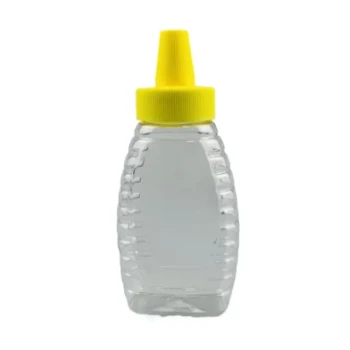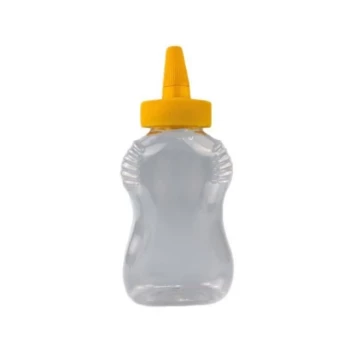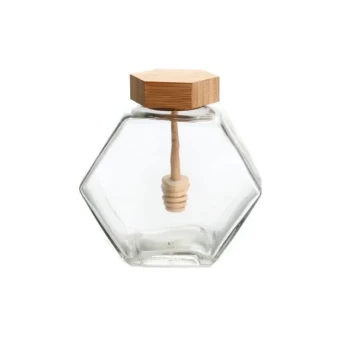At its core, a honey bottle is a tool designed for convenience. The most common features are a squeezable plastic body and a flip-top cap, which work together to allow for clean, controlled dispensing of honey without the stickiness of using a spoon in a traditional jar.
The design of a honey container is a deliberate balance between user convenience for daily use and the critical need to preserve the honey's quality and prevent contamination over time. The choice of material and cap style directly reflects its intended purpose, whether for the kitchen counter or long-term storage.

The Anatomy of a Retail Bottle: Convenience and Control
Modern honey bottles are engineered to solve the primary challenges of handling a viscous, sticky liquid. The design prioritizes ease of use and minimizing waste.
The Squeezable Body
Most honey bottles you find in a store are made from a type of food-grade plastic, like PET. This material is chosen because it is lightweight, shatter-resistant, and flexible enough to be squeezed.
This squeezable feature gives you precise portion control, reducing the mess and waste common with wide-mouth jars.
The Dispensing Cap
The cap is the other half of the convenience equation. Most feature a flip-top lid for easy one-handed opening and closing.
Beneath the cap, there is often a silicone valve. This valve opens under pressure when you squeeze the bottle and snaps shut immediately after, providing a clean cutoff that prevents drips.
The Inverted Design
Many bottles are designed to be stored "upside-down" on their cap. This uses gravity to keep the thick honey pooled at the nozzle, ensuring it's always ready to dispense without a long wait or vigorous shaking.
Material Science: Protecting the Product
While convenience drives the shape of the bottle, the material itself is chosen to protect the honey from degradation. Honey's quality can be compromised by air, moisture, and light.
Food-Grade Plastic
Plastic is the standard for squeezable bottles due to its flexibility and low cost. It must be food-grade to ensure no harmful chemicals leach into the honey. Its light weight also reduces shipping costs.
Glass Jars
Glass is considered the gold standard for long-term honey storage. It is non-porous and inert, meaning it provides a perfect barrier against moisture and oxygen, and it won't impart any flavors.
For maximum protection, opaque or dark-colored glass is superior as it blocks UV light, which can degrade the enzymes and flavor of honey over time.
The Airtight Seal
Regardless of material, a tight-fitting, airtight lid is non-negotiable. Honey is hygroscopic, meaning it will absorb moisture from the air. This excess moisture can raise the water content and lead to fermentation.
Understanding the Trade-offs: Plastic vs. Glass
Choosing between plastic and glass involves weighing convenience against long-term preservation. Neither is universally "better"; they simply serve different functions.
The Case for Plastic
Plastic's primary advantages are convenience and safety. It is lightweight, won't shatter if dropped, and is ideal for the squeezable designs that consumers love for daily use. This makes it a practical choice for households, especially those with children.
However, plastic is slightly more permeable to air than glass over very long periods and is a key focus of environmental and sustainability discussions.
The Case for Glass
Glass offers purity and longevity. It is the best material for preserving the delicate flavor and quality of honey for years. It is also infinitely recyclable and conveys a premium, traditional image.
The main drawbacks are its weight and fragility. Glass jars require a utensil to serve the honey, which can be less convenient and messier than a squeeze bottle.
Beyond the Shelf: Containers for Production and Storage
The small retail bottle is just one type of honey container. Different containers are required for harvesting, processing, and bulk sales.
Harvesting and Small-Scale Storage
Beekeepers often use larger food-grade plastic pails or tubs, with capacities from 2 kg to 20 kg. These must have sealable tops to protect the honey from contaminants and moisture immediately after extraction.
Bulk Commercial Transport
For selling honey in large quantities, producers use containers like 200-liter steel drums. Just like smaller containers, these must be made of food-grade material to prevent oxidation or contamination.
A Critical Warning on Contamination
Never use second-hand containers that were not originally intended for food. Storing honey in non-food-grade plastic or certain metals can cause oxidation and chemical leaching, rendering the honey unsafe to eat.
Making the Right Choice for Your Goal
The right container depends entirely on what you want to achieve.
- If your primary focus is daily convenience: A squeezable plastic bottle with a flip-top cap is your best option for easy, mess-free use.
- If your primary focus is long-term preservation and purity: An airtight glass jar, preferably dark-colored, is the ideal choice to protect honey from degradation.
- If you are a small-scale producer for market: Offer both glass jars for a premium feel and food-grade plastic squeeze bottles to cater to different customer preferences.
- If you are handling honey in bulk: Use only new, food-grade plastic pails or steel drums designed specifically for honey to ensure safety and prevent contamination.
Understanding these features allows you to select a container that not only serves your immediate needs but also protects the integrity of the honey within.
Summary Table:
| Feature | Purpose & Benefit |
|---|---|
| Squeezable Body (Plastic) | Enables precise portion control and mess-free dispensing. |
| Flip-Top Cap with Valve | Allows one-handed use; the valve prevents drips for a clean cut-off. |
| Inverted Design | Uses gravity to keep honey ready to dispense without shaking. |
| Material (Glass/Plastic) | Glass offers purity & long-term preservation; plastic provides safety & convenience. |
| Airtight Seal | Protects honey's quality by preventing moisture absorption and fermentation. |
Are you a commercial apiary or distributor looking for reliable honey packaging?
Choosing the right container is critical for protecting your product and meeting market demands. At HONESTBEE, we supply a full range of high-quality, food-grade honey bottles and bulk containers designed for durability, functionality, and product integrity.
We help businesses like yours streamline operations with wholesale-focused solutions. Contact our team today to discuss your specific needs and discover how our supplies can support your success.
Visual Guide

Related Products
- Classic Beehive Honey Bottle Jar with Squeeze Dispenser Lid
- Ergonomic Squeezable Honey Bottle with Precision Twist Nozzle Cap
- Hexagonal Glass Honey Jar with Wooden Lid Integrated Dipper Elegant Functional Storage
- Squeezable No-Drip Beehive-Shaped Honey Jars with Flip-Top Cap
- Inverted Squeezable Honey Jar with No Drip Flip Top Cap for Easy Pouring
People Also Ask
- How long can you store honey in a 5 gallon bucket? Preserve Quality & Safety for Decades
- What are the advantages of glass containers for honey packaging? Ensure Purity and Elevate Your Brand
- Why should honey not be refrigerated? Preserve its natural texture and quality.
- What types of containers are recommended for storing honey? Preserve Quality with the Right Materials
- What is the best container to store honey long term? Preserve Flavor & Quality for Decades



















